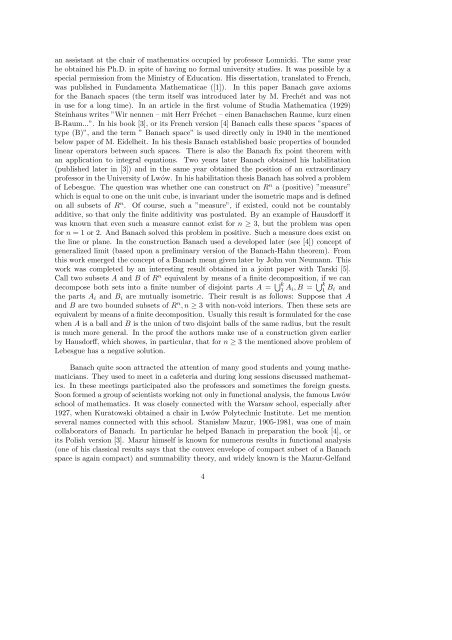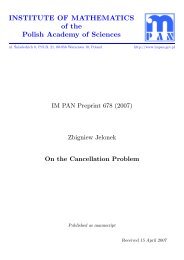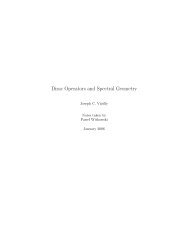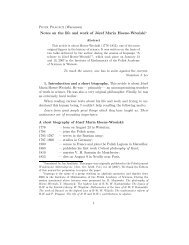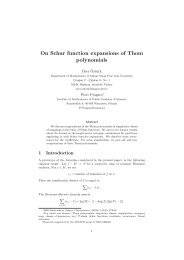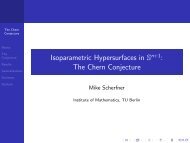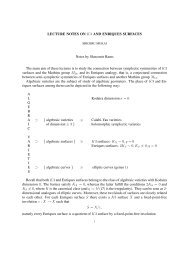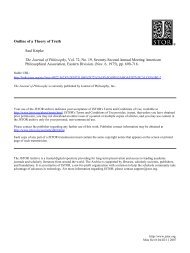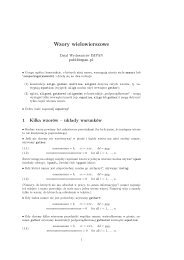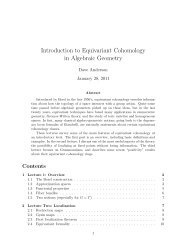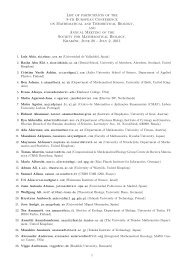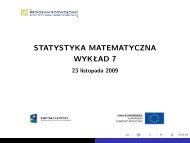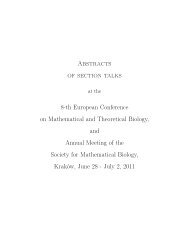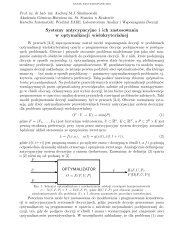A short history of Polish mathematics by W. ËZelazko (Warszawa) In ...
A short history of Polish mathematics by W. ËZelazko (Warszawa) In ...
A short history of Polish mathematics by W. ËZelazko (Warszawa) In ...
Create successful ePaper yourself
Turn your PDF publications into a flip-book with our unique Google optimized e-Paper software.
an assistant at the chair <strong>of</strong> <strong>mathematics</strong> occupied <strong>by</strong> pr<strong>of</strong>essor ̷Lomnicki. The same yearhe obtained his Ph.D. in spite <strong>of</strong> having no formal university studies. It was possible <strong>by</strong> aspecial permission from the Ministry <strong>of</strong> Education. His dissertation, translated to French,was published in Fundamenta Mathematicae ([1]). <strong>In</strong> this paper Banach gave axiomsfor the Banach spaces (the term itself was introduced later <strong>by</strong> M. Frechét and was notin use for a long time). <strong>In</strong> an article in the first volume <strong>of</strong> Studia Mathematica (1929)Steinhaus writes ”Wir nennen – mit Herr Fréchet – einen Banachschen Raume, kurz einenB-Raum...”. <strong>In</strong> his book [3], or its French version [4] Banach calls these spaces ”spaces <strong>of</strong>type (B)”, and the term ” Banach space” is used directly only in 1940 in the mentionedbelow paper <strong>of</strong> M. Eidelheit. <strong>In</strong> his thesis Banach established basic properties <strong>of</strong> boundedlinear operators between such spaces. There is also the Banach fix point theorem withan application to integral equations. Two years later Banach obtained his habilitation(published later in [3]) and in the same year obtained the position <strong>of</strong> an extraordinarypr<strong>of</strong>essor in the University <strong>of</strong> Lwów. <strong>In</strong> his habilitation thesis Banach has solved a problem<strong>of</strong> Lebesgue. The question was whether one can construct on R n a (positive) ”measure”which is equal to one on the unit cube, is invariant under the isometric maps and is definedon all subsets <strong>of</strong> R n . Of course, such a ”measure”, if existed, could not be countablyadditive, so that only the finite additivity was postulated. By an example <strong>of</strong> Hausdorff itwas known that even such a measure cannot exist for n ≥ 3, but the problem was openfor n = 1 or 2. And Banach solved this problem in positive. Such a measure does exist onthe line or plane. <strong>In</strong> the construction Banach used a developed later (see [4]) concept <strong>of</strong>generalized limit (based upon a preliminary version <strong>of</strong> the Banach-Hahn theorem). Fromthis work emerged the concept <strong>of</strong> a Banach mean given later <strong>by</strong> John von Neumann. Thiswork was completed <strong>by</strong> an interesting result obtained in a joint paper with Tarski [5].Call two subsets A and B <strong>of</strong> R n equivalent <strong>by</strong> means <strong>of</strong> a finite decomposition, if we candecompose both sets into a finite number <strong>of</strong> disjoint parts A = ⋃ k1 A i, B = ⋃ k1 B i andthe parts A i and B i are mutually isometric. Their result is as follows: Suppose that Aand B are two bounded subsets <strong>of</strong> R n , n ≥ 3 with non-void interiors. Then these sets areequivalent <strong>by</strong> means <strong>of</strong> a finite decomposition. Usually this result is formulated for the casewhen A is a ball and B is the union <strong>of</strong> two disjoint balls <strong>of</strong> the same radius, but the resultis much more general. <strong>In</strong> the pro<strong>of</strong> the authors make use <strong>of</strong> a construction given earlier<strong>by</strong> Hausdorff, which showes, in particular, that for n ≥ 3 the mentioned above problem <strong>of</strong>Lebesgue has a negative solution.Banach quite soon attracted the attention <strong>of</strong> many good students and young mathematicians.They used to meet in a cafeteria and during long sessions discussed <strong>mathematics</strong>.<strong>In</strong> these meetings participated also the pr<strong>of</strong>essors and sometimes the foreign guests.Soon formed a group <strong>of</strong> scientists working not only in functional analysis, the famous Lwówschool <strong>of</strong> <strong>mathematics</strong>. It was closely connected with the Warsaw school, especially after1927, when Kuratowski obtained a chair in Lwów Polytechnic <strong>In</strong>stitute. Let me mentionseveral names connected with this school. Stanis̷law Mazur, 1905-1981, was one <strong>of</strong> maincollaborators <strong>of</strong> Banach. <strong>In</strong> particular he helped Banach in preparation the book [4], orits <strong>Polish</strong> version [3]. Mazur himself is known for numerous results in functional analysis(one <strong>of</strong> his classical results says that the convex envelope <strong>of</strong> compact subset <strong>of</strong> a Banachspace is again compact) and summability theory, and widely known is the Mazur-Gelfand4


